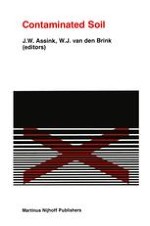F. J. COLON Chairman of the Scientific Committee TNO Division of Technology for Society, APELDOORN, The NETHERLANDS Only these past few years have we gained an insight into the full extent of the problems associated with contaminated soils. The first efforts to take effective remedial action at contaminated sites were seriously hampered by the lack of experience, knowledge and technology. Fortunately, this handicap has been partly alleviated by the experience we have gained in the numerous cases we have had, and -unfortunately still have to deal with. This meeting on contaminated soil is the first international conference to cover such a wide variety of subjects related to the problems that confront us in practice: behaviour of contaminants in soil - impacts on public health and the enviornment - role of governments and other authorities - site investigation and analysis - techniques for remedial action - management of remedial action and risk assessment - safety - case studies This Conference has been organized by the Netherlands Organization for Applied Scientific Research (TNO) in co-operation with the Netherlands Ministry of Housing, Physical Planning and the Environment (VROM). It goes without saying that the preparation would not have been possible without the assistance of many people throughout the world and the co-operation between government, industry and research organizations.
